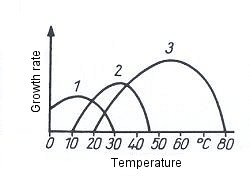- types that thrive at low temperatures (psychrophilic),
- types that thrive at medium temperatures (mesophilic)
- types that thrive at high temperatures (thermophilic), (see Table 4 and Fig. 77)
| Group | Minimum (°C) | Optimum (°C) | Maximum (°C) |
| Cryophilic or psychrophilic microorganisms |
-10 - 0 | 15 - 20 | 20 - 30 |
| Mesophilic microorganisms |
10 - 30 | 20 - 37 | 35 - 50 |
| Thermophilic microorganisms |
25 - 50 | 50 - 65 | 60 - 95 |
Table 4: Classification of microorganisms by temperature group
The optimum temperature is the temperature at which the highest level of multiplication occurs, while the minimum and maximum temperatures represent the lower and upper multiplication limits respectively. However, spores may survive at much higher and lower temperatures.
The most important rot and fermentation pathogens are mesophilic microorganisms. The minimum temperature shows clearly that metabolic activity can be restricted by refrigeration.
Also of relevance to the cargo care of chilled goods are psychrophilic microorganisms, whose minimum temperature may be as low as -10°C (yeasts, molds, bacteria), so meaning that they may still remain active in chilled storage. These may cause secondary infection of chilled goods in refrigerated containers which have not been carefully cleaned.
Molds generally belong to the mesophilic temperature group; however, some types do also thrive on frozen fish and water-containing fats down to temperatures as low as -10°C.
 |
Figure 77: Dependency of bacterial growth on temperature [57] 1 Cryophilic (psychrophilic) types 2 Mesophilic types 3 Thermophilic types |